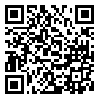Volume 28 - Supplementary
IBJ 2024, 28 - Supplementary: 405-405 |
Back to browse issues page
Download citation:
BibTeX | RIS | EndNote | Medlars | ProCite | Reference Manager | RefWorks
Send citation to:



BibTeX | RIS | EndNote | Medlars | ProCite | Reference Manager | RefWorks
Send citation to:
Shahmirzad N, Akbari Kamrani M, B. Miller W, Farid M. Relationship Between Communication Skills and Childbearing Motivation Among Couples of Reproductive Age at Health Centers in Karaj, 2023-2024. IBJ 2024; 28 :405-405
URL: http://ibj.pasteur.ac.ir/article-1-4842-en.html
URL: http://ibj.pasteur.ac.ir/article-1-4842-en.html
Abstract:
Introduction: Based on the recent changes in fertility patterns and the influence of motivation, the desire to have children can be considered the primary driver of reproductive behavior and a crucial aspect of fertility decision-making in humans. Given that the dynamics of relationships between couples can affect their decision to have children, this study aimed to investigate the relationship between communication skills and childbearing motivation among couples of reproductive age at Health Centers in Karaj during the 2023-2024 period.
Methods and Materials: The present study employed a descriptive-analytical method involving couples of reproductive age who visited comprehensive health centers in Karaj during 2023-2024. The sample consisted of 300 individuals, representing 150 couples, including demographic characteristics, Dastan's communication skills questionnaire, and Miller's childbearing motivation questionnaire, were provided to the participants in printed form. Data analysis was conducted using SPSS software version 26, utilizing central tendency measures, depression statistics, tables, and charts to describe the findings. Bivariate correlation analysis (either Pearson or Spearman) was applied to examine the relationship within the data.
Results: The average age of the women participating in the study was reported as 36.54 (7.155) years, while the average age of the men was 40.75 (7.782) years. Additionally, 80.7% of couples reported having a moderate economic status. The educational attainment of 72% of the participating women and 65.3% of the men was higher than a high school diploma, with the remainder possessing a diploma or lower qualification. Among the couples, 33.3% had one child, 48% had two children, and 18.2% had three or more children. The results showed a significant negative relationship between communication skills and negative childbearing motivation scores among both female (p = 0.002; r = -0.246) and male (p = 0.003; r = -0.240) participants, suggesting that an increase in communication skills was associated with a decrease in negative childbearing motivation scores. Furthermore, a significant positive relationship was found between communication skills and positive childbearing motivation scores among female participants (p = 0.005; rs = 0.230), whereas a non-significant positive relationship was observed among male participants (p = 0.840; rs = 0.017). Overall, increased communication skills were linked to higher positive childbearing motivation scores.
Conclusion and Discussion: Communication skills are one of the factors influencing couples' childbearing motivation. Therefore, implementing counseling programs to enhance communication skills may be an effective strategy to boost motivation and ultimately increase the couples’ decisions regarding fertility.

Methods and Materials: The present study employed a descriptive-analytical method involving couples of reproductive age who visited comprehensive health centers in Karaj during 2023-2024. The sample consisted of 300 individuals, representing 150 couples, including demographic characteristics, Dastan's communication skills questionnaire, and Miller's childbearing motivation questionnaire, were provided to the participants in printed form. Data analysis was conducted using SPSS software version 26, utilizing central tendency measures, depression statistics, tables, and charts to describe the findings. Bivariate correlation analysis (either Pearson or Spearman) was applied to examine the relationship within the data.
Results: The average age of the women participating in the study was reported as 36.54 (7.155) years, while the average age of the men was 40.75 (7.782) years. Additionally, 80.7% of couples reported having a moderate economic status. The educational attainment of 72% of the participating women and 65.3% of the men was higher than a high school diploma, with the remainder possessing a diploma or lower qualification. Among the couples, 33.3% had one child, 48% had two children, and 18.2% had three or more children. The results showed a significant negative relationship between communication skills and negative childbearing motivation scores among both female (p = 0.002; r = -0.246) and male (p = 0.003; r = -0.240) participants, suggesting that an increase in communication skills was associated with a decrease in negative childbearing motivation scores. Furthermore, a significant positive relationship was found between communication skills and positive childbearing motivation scores among female participants (p = 0.005; rs = 0.230), whereas a non-significant positive relationship was observed among male participants (p = 0.840; rs = 0.017). Overall, increased communication skills were linked to higher positive childbearing motivation scores.
Conclusion and Discussion: Communication skills are one of the factors influencing couples' childbearing motivation. Therefore, implementing counseling programs to enhance communication skills may be an effective strategy to boost motivation and ultimately increase the couples’ decisions regarding fertility.

| Rights and permissions | |
 |
This work is licensed under a Creative Commons Attribution-NonCommercial 4.0 International License. |







.png)
